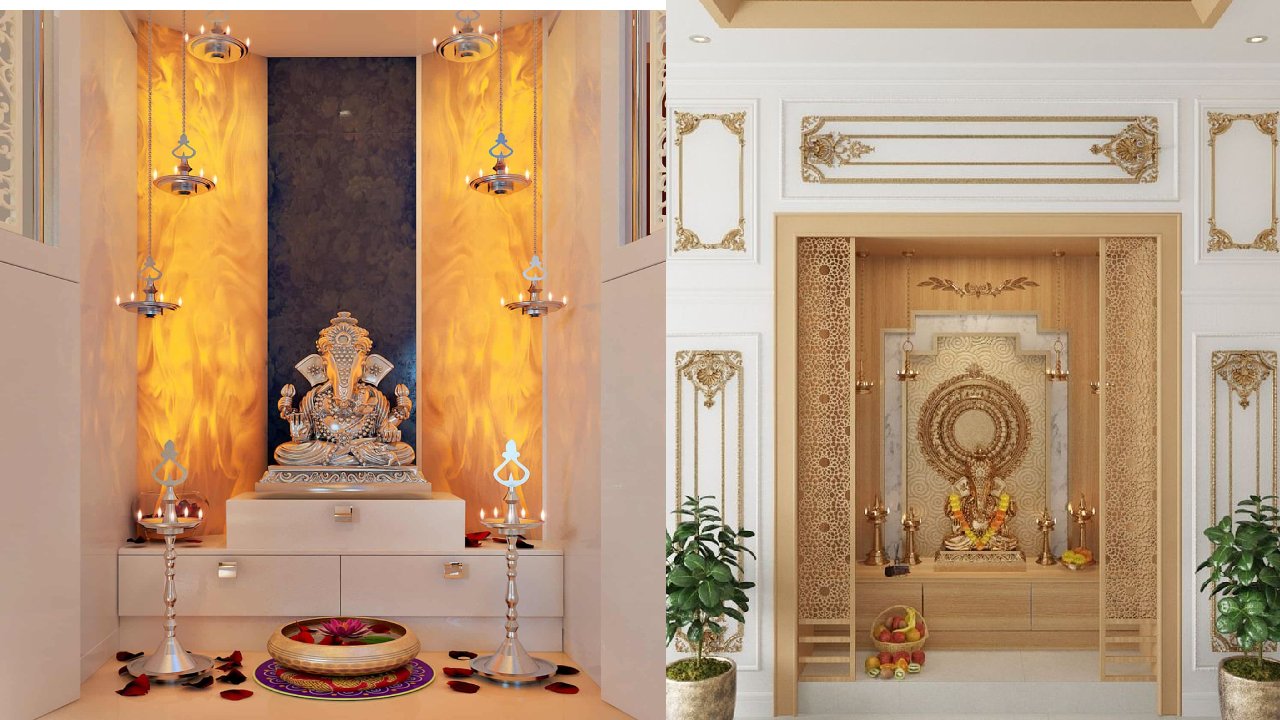Significance of pooja room
The pooja room serves as a dedicated section in our homes where we reverently place our deities and other sacred items to offer prayers to the gods. In large cities, where living space is scarce, many residential homes lack a separate pooja room, and some people do not prioritize having one.
Having a well-aligned pooja room helps mitigate negative energies that may be present in our homes, thereby ensuring that our prayers yield the most fruitful results. Ultimately, this contributes to a healthy, happy, and fulfilling life ahead.
Fundamentals of pooja room
Vastu for the pooja Room involves a detailed analysis that takes into account various aspects of the room and its contents. The primary focus is on identifying the ideal placement zone for the pooja room, followed by arranging the interiors accordingly.
Certain fundamental Vastu guidelines are essential to adhere to, and these include
- Maintaining cleanliness in the puja room at all times.
- Removing or replacing idols or pictures that are broken or damaged.
- Ensuring ample light in the puja room.
- Avoiding clutter in and around the puja room.
During the Vastu analysis for the Pooja Room, our Vastu expert – Dr.Pavan Sharma Guruji typically provides a comprehensive list of these vital Vastu guidelines to be followed.
Avoid these things
- Under a staircase
- Directly in front of the main door
- Adjacent to a toilet
- Sharing a wall with a toilet or bathing room.
8 Vastu tips for pooja room
Here are 8 vastu tips for Pooja room. Let’s explore some essential Vastu tips to enhance the sanctity and serenity of your Pooja room.
Pooja Room Direction
The positioning of the pooja room greatly influences its auspicious aura, following Vastu principles. The northeast direction holds the highest significance, with the east and north orientations also considered favorable. When designing a new home and having control over the pooja room’s placement, it is highly advisable to avoid the basement or upper floors. The ground level is the most ideal position to ensure the free flow of blessings and positive energies.
Pooja Room Design
According to Vastu principles, it is recommended to have a pooja room with a low ceiling. Adding a pyramid-shaped or gopura-like top can enhance the positive atmosphere. If space permits, consider incorporating a threshold and a two-door entry, as these elements facilitate a continuous flow of energy and attract positivity.
In smaller houses or apartments where dedicating an entire room to a Mandir is challenging, you can follow these Pooja Room Vastu tips to increase the flow of positive energy
- For north or east-facing flats, try to align the Pooja room in the north, northeast, or east direction.
- Given the limited space, opt for a lower ceiling with a pyramid or gopura-shaped top, which adds symmetry and creates a meditative atmosphere as per Pooja Room Vastu.
- If possible, add a threshold and a two-door entry, preferably made of wood, as this helps keep pests and ants out of this sacred space.
Pooja room Idol Placement
The ideal placement is a few inches away from the wall and at least six inches above the ground. It’s essential to avoid placing portraits of the deceased and paintings depicting violence in the pooja room.
Keeping the idol away from the wall promotes continuous airflow around it, while also allowing the fragrance of incense sticks to envelop the idol. This setup enhances the sacred atmosphere and reverence in the pooja room.
Tips for positioning idols in the pooja room
When designing a puja room, it is essential to check if the gods’ idols face the correct direction in your home. Avoid covering the face of the god idols with garlands and flowers. Instead, always keep solid statues of the gods and avoid hollow ones in the pooja room.
According to Vastu, avoid placing the idols directly on the floor in the mandir. It is advisable to steer clear of large idols and opt for small ones as per pooja room Vastu guidelines for home, preferably around seven inches in size.
To adhere to Vastu Shastra guidelines, avoid placing idols of deities leaning against the walls in the mandir or pooja room at home. Maintain a minimum gap of one and a half inches between the idols and the wall to allow smooth flow of energies and incense throughout the room.
Moreover, do not place the platform right against the walls; leave a small gap to facilitate the free flow of energy around the space and elevate the Vastu for the pooja Room. This arrangement will contribute to a more harmonious and spiritually uplifting environment.
In addition to ensuring the right home temple direction, it is crucial to keep the temple at a higher level, a few feet above the ground, so that the idols are at the level of the devotee’s chest. This positioning allows for comfortable prayers in both sitting and standing positions
The height between the floor and the base of the mandir should be approximately 32-36 inches. Avoid placing the idol directly on the floor.
Pooja Room Storage
Unsure about where to keep your religious books, lamps, and pooja-related items? According to pooja room Vastu, ensure that the storage points towards the southeast direction, and avoid placing anything above the idol.
Positioning the storage towards the southeast ensures that sunlight entering the pooja room remains unobstructed. Avoid keeping unnecessary items below the pooja room or placing dustbins in this area. When using water in the pooja room, opt for copper vessels and remember to change the water in the kalash daily.
Maintaining cleanliness and avoiding clutter are crucial in your pooja room to discourage negativity and maintain the flow of positive energy. Here are some essential considerations:
- Place storage cabinets in the west or south quadrants of the room, ensuring uninterrupted entry of natural light.
- Store prayer books neatly in the cabinets to avoid clutter.
- Keep the wicks organized and ensure the lamp is always clean.
According to pooja room Vastu, the pooja room should be constructed using marble or wood, while glass or acrylic materials should be avoided. It is essential to avoid multiple idols of the same God or Goddess, either in a seating or standing position. Cracked or damaged idols or photos should not be placed in the pooja room as it is considered inauspicious.
Pooja Room Colors
Colors play a significant role in shaping the vibe and energy of a room, as per Vastu science. Each color holds specific meanings and represents elements of nature, making them beneficial when applied following Vastu rules.
In general, light colors are the ideal choice for a puja room, as they facilitate the better channeling of positive energies and create an ideal environment for offering prayers. According to Pooja Room Vastu, light and muted shades enhance brightness and improve concentration, making a light color palette highly recommended. Options like white, light blue, beige, lavender, orange, cream, and light yellow promote a calming and positive ambiance. When selecting marbles, shades of white, pale yellow, or ochre contribute to a meditative energy in the room. It is essential to strictly avoid dark brown and black colors.
Pooja room Lighting
Light serves as a vital source of positive energy, making it essential to have a natural light source in your pooja room. The ideal placement for a window is in the northeast direction, as per Vastu.
In adherence to Vastu for the pooja room, you can use artificial lighting to illuminate the space if there are no windows.It is advised to keep the room illuminated and well-lit at all times. Vastu experts recommend installing bright artificial lights that can be used to maintain the room’s brightness even after sunset. This ensures a serene and spiritually uplifting ambiance in the pooja room.
Pooja room Doors
Having a separate pooja room or a home pooja room is essential, and it should be equipped with doors to ensure privacy during worship and maintain the sacredness of the space by keeping pests or insects at bay. The threshold of the pooja room plays a significant role in spreading auspicious energies throughout the house, making the entrance to the pooja room of utmost importance in Vastu guidelines.
To adhere to Vastu principles, ensure that the pooja room has a proper door. A mandir without a door loses its sanctity and becomes like any other room in the house. Gods deserve their dedicated space! When choosing doors, opt for wood as the primary material and select a design with two shutters and a threshold to effectively ward off pests and insects from entering the sacred space. This arrangement contributes to maintaining the purity and sanctity of the pooja room.
Pooja room Accessories
According to Vastu, incorporating metallic accessories, particularly brass, for the decoration of your pooja room is highly beneficial. Additionally, keeping a copper vessel filled with water in the pooja room serves to absorb negativity that may linger in your home. Metal generates a spiritual sound that aids in purifying the energy within your living space.
Leather is considered impure and should not be placed in the temple space. Avoid keeping animal skin or any leather items in the pooja room. Furthermore, it is advised to refrain from keeping money in the pooja room. Following these guidelines will help maintain the sanctity and purity of your pooja room.
Items to Include in the Pooja Room for Good Luck
As per Vastu Shastra and Feng Shui experts, keeping these auspicious items will attract positive energies.
To create a divine ambience and cleanse the area, light aroma candles, dhoop, or incense sticks in your pooja room. Place a red-colored cloth beneath the photographs or idols for added auspiciousness.
In home pooja rooms, it is recommended to keep a bell on the left side as per mandir Vastu since the sound of the bell wards off negative energy.Ensure that the north and northeast corners of your pooja room are free from any heavy objects to avoid blocking the flow of money in the house. Avoid keeping unnecessary items below the temple or placing dustbins in this area. Also, refrain from storing anything above the idols. For water, use copper vessels and remember to change the water in the kalash daily.
Adorn the floor with rangoli designs to attract positive vibes and exude joy. Drawing Swastik and Om symbols on the northeast wall brings prosperity, according to Vastu.
In any temple or home mandir, oil lamps or diyas are essential elements. The Agni kund used for performing havan can also be kept in the puja area. As per Vastu Shastra, the southeast direction is the best location for Diyas and Agni Kund, as it is associated with the fire element. Diyas can also be placed in the east or north to attract good health and wealth, respectively.
The puja thali kept in the pooja room symbolizes the five cosmic elements – earth, water, fire, wind, and sky. It is one of the ways to worship the divine energies. The puja thali can be made of silver, brass, copper, meenakari embellishment, or steel. Always keep rice, kumkum, turmeric (powder or whole pieces), Diya, and flowers in the puja thali. You can also include sandalwood paste, betel leaves or betel nuts, Kalash, and Prasad if possible, or keep them separately.
Following these practices, will enhance the spiritual atmosphere and sacredness of your pooja room.


Casino Roulette: Spin for the Ultimate Thrill
Experience the timeless excitement of Casino Roulette, where every spin brings a chance to win big and feel the rush of luck. Try your hand at the wheel today at https://k8o.jp/ !